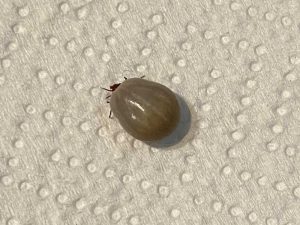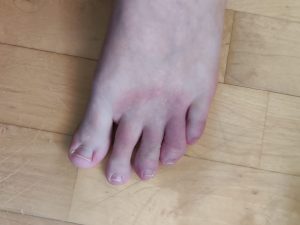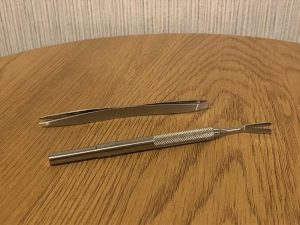Ticks are common in Finland and if you spend time outdoors, you should be careful not to get bitten by a tick. Ticks can carry various diseases that can be problematic. Here’s all you need to know about ticks in Finland if you are planning on spending some time out in the nature.
Ticks seek animals in order to feed on their blood and they are common on mammals such as mice, vole, and deer. Ticks have almost no preferences when it comes to their host animals, so they attach themselves to humans and even amphibians and snakes. Ticks can also travel on migrating birds. There are two common species of ticks in Finland; common European tick, Ixodus ricinus, which is native here, and Siberian tick, Ixodus persulcatus, which has likely come here from the east. A nymph is a two-year-old mite and only 1–2 mm long, while an adult tick is 5–10 mm long.
The most tick-infested places are lush forests and meadows in southern Finland. Ticks are common in archipelago and by lake shores in general. There can be ticks even in city parks. The good news is, ticks are not that common in Lapland.
When is tick season in Finland?
Tick season in Finland begins as soon as the snow has melted. Ticks are active when the temperature is above 5 degrees, so you can encounter them from April to November. Last autumn was so warm that I saw ticks even in late November. It’s also not unheard of to get a tick bite in winter.
Are ticks in Finland dangerous?


About 500 000 people in Finland get bitten by a tick every year. Not all ticks carry diseases, but ticks can spread various diseases, such as tick-borne encephalitis (TBE) caused by a virus and borreliosis caused by a bacterium called borrelia. In fact, ticks can carry around twenty different diseases.
The TBE can be a dangerous condition. Unfortunately, if we are bitten by one of the few ticks with TBE we are infected almost immediately, because it spreads from its saliva. Chances of getting TBE in Finland is considered low, about 150 people got it in 2021. The risk areas of encephalitis are mainly limited to coastal areas. See the map of TBE provided by Finnish institute for health and welfare. There is a vaccination against TBE for those who reside in risk areas in long term.
About 3000-4000 people get sick with borreliosis, also known as the Lyme disease, in Finland every year. About 20-25% of ticks carry the borrelia, so even if you get bitten by one, you might not get borreliosis. There is no vaccination against borreliosis, but it needs to be treated with antibiotics. Typical symptoms include fever, headache, fatigue, and a characteristic skin rash.
What to do in case of a tick bite


Ticks don’t suck blood like mosquitos nor sting like bees. Once a tick has attached to a host, it injects it with saliva. This contains enzymes that break down the cells beneath the skin, as well as an anticoagulant, so the blood flow doesn’t clot. Then the tick starts to eat from the cell soup that has formed in the wound.
If a tick bites you, it takes about 2-7 days to eat until it lets go and drops off. If you have a tick, remove it as soon as possible. If the tick remains on the skin for more than 24 hours, the probability of catching the Lyme disease increases significantly if the tick carries the disease. This is because the Lyme disease is transferred when the tick has eaten and then regurgitates undigestible leftovers back into the host. The bacteria found in the tick’s stomach are carried along, infecting the host.
After you have removed the tick, keep an eye on the area where the tick was. Borreliosis often causes a circular and expanding rash around the place where the tick has been. If you have a rash or fever after the tick bite, go to a doctor. There is a blood test available for borreliosis, to confirm if the antibiotics are needed.
How to remove ticks


If you go trekking, I recommend you to pack with you a special tool for removing ticks. My preferred weapon of choice is usually a V-shaped tick iron, but it works better on bigger ticks rather than nymphs. It’s a tool that you can simply push under the tick and pull it straight upwards. Some old instructions say that you should twist or jerk the tick of the skin, but in my opinion, twisting might break the tick in half, leaving part of it still attached to the skin. That could cause some inflammation around the bite site. Tweezers can work better for small ticks, but even with them, you should try to crab the tick from as close to its head as possible and then pull it straight upwards. It takes some determination, but you can do it!
After you have removed the tick, you should disinfect the area it was attached to as well as the tool you used. And don’t forget to wash your hands. What do you do with the tick once it’s removed? Try not to touch it. You could burn it or drown it in alcohol. If you must throw the tick to trash, seal it in a bag that closes tightly. Never crush it between your fingers.
Don’t try any other stuff such as butter, oil, nor alcohol for removing the tick, don’t twist it nor crush it onto your skin as those could increase the chances of pathogens entering your body. If you an unsure about your skills of removing living ticks, you can also find a freezing spray from pharmacies in Finland. The spray freezes the tick in an instant while it is still attached and allows you to remove it easier. I do not use the spray since I’m mainly removing ticks from a dog, who is more scared of the spray than my tick iron or tweezers.
How to protect yourself from ticks
The easiest way to protect yourself from ticks is clothing and avoiding grassy areas. Stay on clear paths rather than wonder in the bushes.
- Wear long trousers and long-sleeve shirts
- Tuck your pants into your socks
- Use long rubber boots
- Use insect repellent on skin that is exposed
- Wear light-colored clothing that helps you spot the ticks easier
After spending time outdoors, it’s important to check your skin thoroughly from ticks. Pay a special attention to your hair and back.
Don’t forget to protect your pets
Remember to protect your pets from ticks, and check them regularly as well. Pets can bring ticks indoors or inside your tent. I recommend speaking to a vet about your options for tick protection for your pet. There are many types of protection available from collars to scarves and from pills to drops. Animals can also suffer from borreliosis, anaplasmosis, and tick-borne encephalitis. I know a dog that had 57 ticks removed at once.
The number of ticks in Finland has been increasing for a few decades, especially in established tick areas such as the archipelago and Lakeland. The increase in numbers is due to favorable living conditions of ticks and their host animals such as deer. The increase in tick bites is maybe contributed by the pandemic as more people go out in the nature than usual and risk being bitten.
Do you have any experience on ticks? Or tips for preventing their bites?
You might find also these posts interesting
- Deer keds that annoy the crap out of you in the autumn
- Hiking with a dog – on the terms of a dog
- A local’s guide to hiking in Finland
- What to pack for a superb day hike in Finland


This does, indeed, seem to contain all you need to know about ticks. Thank you.